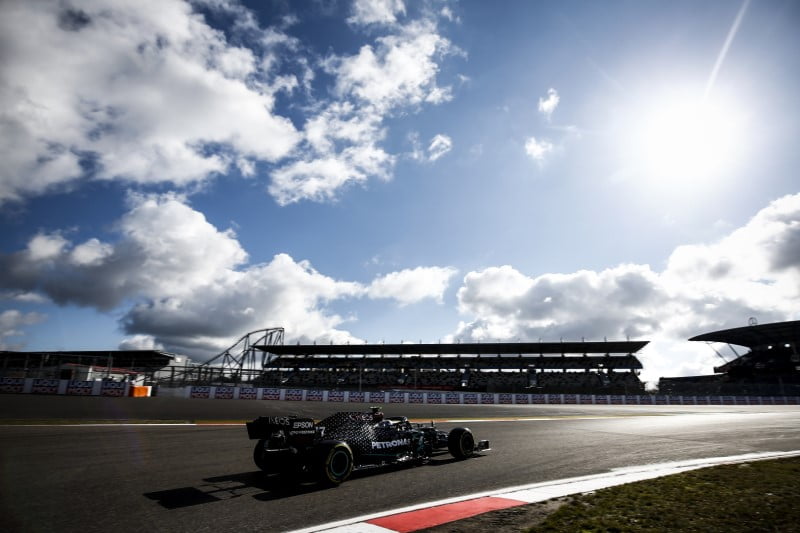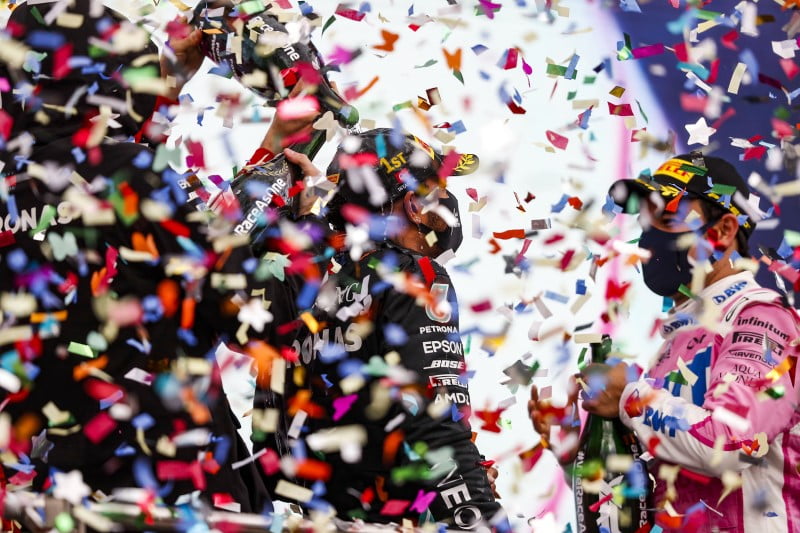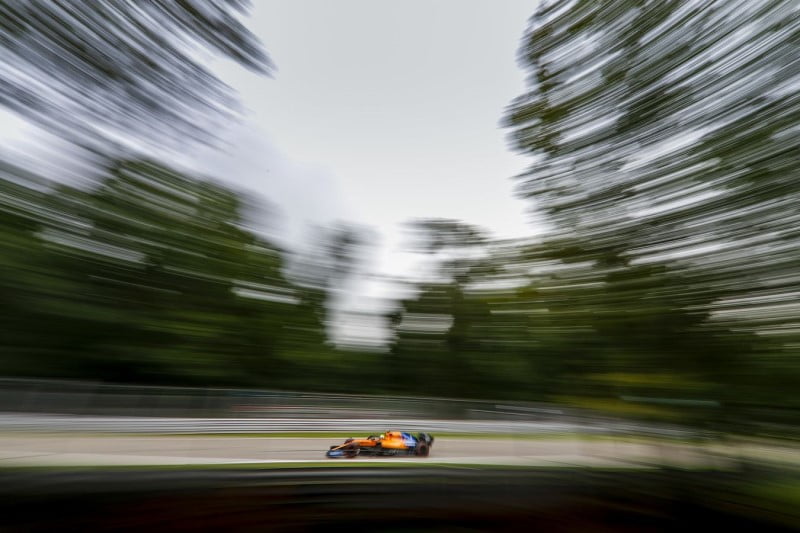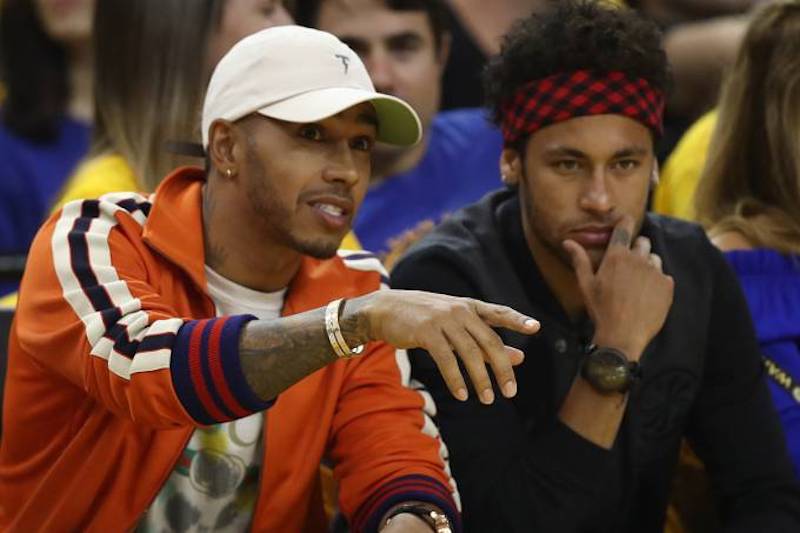Key moments from 2020 Formula 1 season: although we saw predictable World Champions (Lewis Hamilton and Mercedes), 2020 was a largely unpredictable and unprecedented season for Formula 1. As we bring this year to a close, let’s revisit some of the key moments from the season.
Year 2020 will be remembered as the one that nobody saw coming – and the 2020 Formula 1 season reflects the sentiment. Although we saw predictable World Champions (Lewis Hamilton and Mercedes), it was an unpredictable and unprecedented season.
As we bring this year to a close, let’s revisit some of the key moments of the 2020 Formula 1 season.
COVID-19 Impact
After horribly mismanaging the originally planned opening round of the season in Australia, Liberty Media and the FIA did extremely well to host 17 races between July and December. It’s easy to assume why organising the 2020 Formula 1 season would have stretched the teams more than ever before. At first, only eight races were announced – presumably enough to label the season as a ‘World Championship’ based on the FIA’s sporting regulations. As the first part of the season progressed, Formula 1 announced races on-the-go – at one point the participants not knowing whether the championship would be decided over 12, 15 or more races.
The other impact was on the drivers – most of them being forced to remain in their own bubbles and spend weeks away from home. Pierre Gasly’s house was burgled while Lewis Hamilton commented that this season took more away from him on the personal front than ever before. And of course, three drivers missing out on races due to being infected by the virus – Sergio Perez, Lance Stroll, and then Hamilton himself.
We are going to relive the 2020 season through the power of the GIF… ?
And we begin with this wholesome @danielricciardo moment ?#F1 pic.twitter.com/pvCcwBx9LR
— Formula 1 (@F1) December 17, 2020
Calendar
The COVID-19 impact saw Formula 1 scrap the original calendar for 2020 and offer a far bolder revised version. A handful of circuits returned to host races (Portimao, Nurburgring, Turkey among others) while a few (Mugello) hosted their first-ever Formula 1 Grand Prix. The addition of new and returning venues increased unpredictability of form (except for Mercedes’) and offered edge-of-seat action. In fact, if there’s ever a calendar for Formula 1 to seek inspiration from for the future, it should be the one forced upon the sport in 2020.
Apart from venues, Formula 1 also experimented with a shorter weekend format for the race in Imola. While teams offered a mixed view on whether this should be the new format to follow in the future, one can expect Formula 1 to pursue such experiments as it works to increase the total number of races in a year to 25.
Project Pitlane
Before the teams fought for Championship honours, they came together for Project Pitlane – Formula 1’s contribution towards the fight against COVID-19 . The teams used their advanced understanding of technology to help with the manufacturing of respiratory devices. This included rapid design, prototype manufacturing, test, and skilled assembly. From assisting only the automobile industry, Formula 1 teams were now assisting humanity at large.
Is Mercedes The GOAT In F1?
Lewis Hamilton, Car #44 & Sergio Perez
‘Is it the car or is it the driver?’ – the never-to-be-settled debate led us to ask if Mercedes were the true GOAT of Formula 1 teams. Irrespective of the team’s superiority, the 2020 Formula 1 season will be remembered for Hamilton’s record-breaking performance including his victory on three-wheels at Silverstone. He equalled and bettered several seemingly unbreakable all-time records of Michael Schumacher. A not-so-popular opinion would be that the 2020 Formula 1 season resembled the 2019 MotoGP season. While Hamilton-Mercedes dominated to extend their record-breaking run (just like Marquez-Honda in MotoGP), the rest of the grid entertained and kept up the excitement.
As for Car #44, it was the class of the field during the 2020 Sakhir Grand Prix – the race that Hamilton was forced to sit out due to COVID-19 . Re-stickered as Car #63, George Russell grabbed his lone chance to race a Mercedes and it was only a mix of team error and bad luck that cost the Briton a win on his three-star debut.
But will the 2020 season be remembered more for Sergio Perez’s consistent performances than Hamilton’s record-breaking run? The Mexican faced it all – a surprise team decision to replace him, being infected by COVID-19 and missing a couple of races, delayed upgrades, and reliability gremlins. The Force India / Racing Point veteran rose above it all to claim his maiden Formula 1 win, finish P4 in the Drivers’ Championship and earn a drive with the more-coveted Red Bull Racing team for 2021.
Say another hello to those friendly podium robots ???#F1 pic.twitter.com/HeuuIiilG2
— Formula 1 (@F1) December 19, 2020
Racing Point vs Others
Racing Point’s ‘pink Mercedes’ approach raised eyebrows and suspicion in the early races of the season prompting the FIA to issue clarifications for 2021 so that other teams don’t ‘copy’ their rivals’ designs outright. But before the clarification and a settlement between the teams, the paddock was split into two – Racing Point and Mercedes versus the rest. It was a throwback to the good old times when it was common for different interpretations of the rule book to cause a rift between the teams. By the end of this saga, it was Formula 1 that got wiser. The powers that control the sport took the steps necessary to safeguard the sport’s DNA to have ‘independent’ constructors.
As for Racing Point, they were the season’s biggest underachievers. For a car that adapted to every track, the team lost third place in the Constructors’ Championship to Mclaren at the last race of the season. But of course, they were disadvantaged by the 15 points that were docked from their total as a result of their ‘pink Mercedes’ design approach. On the business side of things, the loss of earning from finishing fourth instead of third only added to the not-so-hefty €400,000 penalty for their transgressions. If only, Racing Point’s driver decisions were as smart as their design decisions.
How Simulation Tools Helped F1 Teams In 2020
Mclaren and the battle for P3
The superpower of the 90s beat Racing Point to third place in the Constructors’ Championship in what would be labeled as an all-round team performance. After their nightmare days with Honda a few seasons ago, Mclaren’s steady rise through the rankings was a delight to follow. The Carlos Sainz Jr-Lando Norris show was on-the-ball, off-track, and on it. In the battle for P3, two factors stood out for Mclaren. First, they seldom had the third-fastest car. The Racing Point and Renault certainly seemed quicker. The second factor more than made up for the first – the Sainz-Norris pair scored evenly and had the least gap between them when compared to the drivers racing for their immediate rivals.
Mclaren-Mercedes But No Red Bull-Mercedes, Oh The Irony!
But before Mclaren’s achievement, the battle for P3 was closely fought in the races and in the championship. In the races, Max Verstappen’s retirement from 5 out of 17 races and Alexander Albon repeatedly running with the mid-field pack opened up opportunities for new podium finishers in the season. In the end, nine drivers stood on the third step of the podium in a season when most would’ve expected the podium honours to be hogged by the Mercedes drivers and Verstappen.
As for the Constructors’ Championship, the interest in the Renault vs Racing Point vs Mclaren vs Ferrari’s battle for P3 made up for the lack of a championship challenge for Mercedes. It was heartening to see all teams score multiple podiums through the course of a season. In the winter period, look out for Cyril Abiteboul’s tattoo – a podium bet that he lost to Daniel Ricciardo!
OutSTAND-INg! ?
Drivers queue up to congratulate @HulkHulkenberg after he qualifies P3 for the 70th Anniversary Grand Prix #F1 pic.twitter.com/5pLxiisTCk
— Formula 1 (@F1) December 21, 2020
Surprise Winners
For the first time since 2012, Formula 1 had more different winners in the season. Apart from the trio of Hamilton-Bottas-Verstappen claiming wins, Alpha Tauri’s Pierre Gasly won the race in Monza (courtesy a Mercedes pit-stop gaffe) while Sergio Perez claimed his and Racing Point’s first win at the race in Sakhir – also courtesy a Mercedes pit-stop gaffe.
The other surprise was that both Verstappen and Bottas claimed only two wins apiece, despite the Finn being in the far more competitive Mercedes.
Activism
Probably for the first time in the sport’s history, the platform of Formula 1 was used extensively towards promoting off-track activism. While Formula 1 launched the ‘We Race As One’ campaign to support equality, Hamilton garnered support from most of his rivals to take the knee in support of the global campaign – Black Lives Matter. The reigning World Champion also launched the ‘Hamilton Commission’ to make Motorsport as diverse as possible.
Along with setting records in the Formula 1 World Championships, Mercedes extended their support towards anti-racism by changing their iconic ‘Silver Arrows’ to ‘Black Arrows’ for 2020 (and they will continue to do so in 2021) and by introducing an initiative called ‘Accelerate 25’ to make the team more inclusive and diverse.
Bromance
The structure of the Formula 1 World Championships requires a unique dynamic from the drivers – that of being team-mates and arch-rivals at the same time. The influx of younger drivers in the sport and them embracing social media has seen a rise in bromance – the tales of several drivers and their friendships entertaining us throughout – whether it was Sebastian Vettel’s support and cheering of Hamilton and his activism to the bromance between the Mclaren drivers and the ever-joyous Daniel Ricciardo.
The standout has to be the camaraderie shared between George Russell, Alexander Albon, Charles Leclerc, and Norris – each coming out in support and helping their mates endure the tough times that racing in Formula 1 throws time and again.
The Formula 1 teams shared a unique bromance, too. They held together during the pandemic despite being forced to not race in the first half of the year. Apart from Project Pitlane, they also came together to sign off on landmark regulations for a better future for the sports – a budget cap, new Concorde Agreement among others.
Monza marked the end of an era for @WilliamsRacing ?#F1 pic.twitter.com/mb1H8dlPa9
— Formula 1 (@F1) December 21, 2020
Investments
Liberty Media’s pushing of revolutionary reforms in the sport (spends and earnings of teams) was expected to attract new investors towards the sport and the teams. In no time after announcing the reforms, two of Formula 1’s oldest teams, Williams and Mclaren, announced new investors – even before the reforms kicked into action. The Williams family sold off their team to Dorilton Capital while Mclaren sold a minority stake to MSP Sports Capital. There were talks about the Haas F1 Team selling a stake, too. Maybe this story will follow in 2021?
Driver Silly Season
Even before a single lap was raced, there were a multitude of driver changes announced. Ferrari let go of Sebastian Vettel and hired Carlos Sainz Jr from Mclaren as his replacement. Daniel Ricciardo took this opportunity to jump from Renault to Mclaren while Renault announced that they would bring back the former two-time World Champion Fernando Alonso in 2021.
Vettel was lured by Racing Point (to be branded as Aston Martin F1 Team in 2021) – who decided to replace their star driver Perez. After being handed a full season (in addition to the races in 2019) to prove himself, Red Bull Racing hired Perez and assigned reserve driver duties to Albon. Elsewhere, the Haas F1 Team decided to field an entirely new line-up for 2021. Rookies Nikita Mazepin and Mick Schumacher will replace Kevin Magnussen and Romain Grosjean next season.
At the time of writing this post, Mercedes were yet to announce the re-signing of Hamilton’s services – but it’s well-known that such a signing would be a mere formality. This means that in 2021, only three teams would have an unchanged line-up – Mercedes, Alfa Romeo, and Williams.
Iconic ?#F1 pic.twitter.com/KQM9p5xCDI
— Formula 1 (@F1) December 25, 2020
Super-sub
Typically, the role of a reserve driver is fairly limited during a ‘regular’ Formula 1 season. However, in 2020, COVID-19 infections to regular drivers saw reserve drivers get the nod to go racing. Nico Hulkenberg reminded the paddock of his talent inside a cockpit in the three races he raced in for Racing Point – scoring an impressive 10 points in a car he’s never raced before.
After much deliberations, Mercedes decided to promote George Russell to replace Hamilton instead of using the services of their reserve driver Stoffel Vandoorne. An unofficial shoot-out for the Mercedes seat in 2022 ensued between Bottas and Russell at Sakhir. The Haas F1 Team used the services of their reserve driver Pietro Fittipaldi in the last two races of the season (in place of Grosjean).
WHAT IF Aston Martin F1 Team Uses Vettel To Make Stroll Look Good?
Safety
Last but not the least, the 2020 Formula 1 season sealed the debate in favour of the halo for good. Romain Grosjean climbing out alive of his burning car after crashing on the opening lap of the 2020 Bahrain Grand Prix made global headlines. His survival was testimony to the FIA and Formula 1’s relentless pursuit of safety over the decades. However, it was a shock reminder of just how dangerous Motorsport can be despite advancements in safety.
This post was first published on Firstpost.














